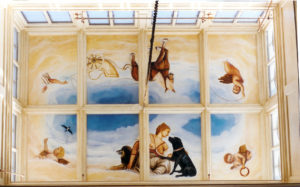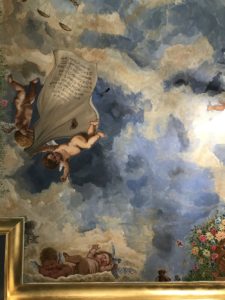04 Aug Myths About Mural painting
The biggest common myth about mural painters is that renaissance artists, particularly Michael Angelo painted huge ceilings (the Sistine Chapel) lying down on the platform. However I believe there was possibly an element of truth in this, the renaissance was a huge leap forward in the sciences, medicine, and commercial enterprises. Leonardo de
Vinci was designing flying machines’ weapons for war-making breakthroughs in all areas, the renaissance period represented the largest leap forward until the present day advances in all areas of technology.

It is not surprising that Michael Angelo designed sets of platforms including, I believe a moving reclining platform that had small wheels that you could lie on and propel himself gradually allowing him to keep painting with a fluidity of movement. This moving wooden cot moved over the platform on the scaffolding and would have been the perfect height to work at whilst reclined. There were of course great areas that could only be done standing and he wrote poems to his father at the time of the pains and aches that this caused.
Another possible myth about the Sistine chapel is that it was all painted using the ‘buon fresco technique’ which is painting over fresh plaster whilst it is wet, whilst there is evidence that a lot of this was the case in much of the detailed work the ‘fresco secco technique, in which the artist paints on a dry plaster surface. It could even be possible that he went over the detailed work, especially the faces working over the plaster whilst it was dry.

No doubt that the majority was completed in buon fresco as this sealed in the color pigments and helped the longevity of the color fastness, which has allowed the work ( with renovation) to survive the centuries.
One of the modern-day myths about murals is the cost, just because a mural is large it does not mean the materials need to cost a lot. For the beginner who wants to paint their own mural a lot of money can be saved using household white paint ( it can be the same as is used for the base coats) this paint can be used to mix with pigments, these can be student quality and a large interior mural can be painted for just hundreds of pounds. Exterior walls for murals that will have to stand up to the weather need to be thought through as to get the best results exterior you will need to use semi-porous breathable paints.
Another popular myth is that all murals are painted directly onto a ceiling or wall when in fact for several century’s muralists have used the marouflage technique of painting onto canvas in the studio and shipping the finished mural to the pasted onto the wall or ceiling at the final location. I will add two images of ceiling murals one painted directly onto the ceiling and the other on canvas to see if you can see the difference.




No Comments